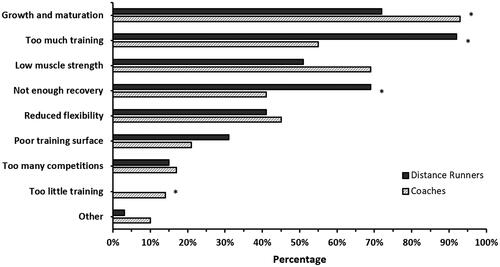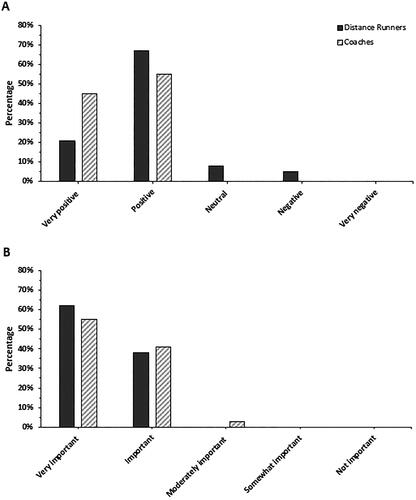Figures & data
Table 1. Characteristics of competitive adolescent distance runners and distance running coaches.
Table 2. Questions and responses about the current knowledge and behavior of distance runners and coaches in relation to RRI prevention.
Figure 1. Current understanding of the most common causes of running-related injury for distance runners and coaches. The different causes of running-related injury are shown in order from most (top) to least (bottom) commonly selected by all participants. ‘Other’ causes of running-related injury included: (1) inconsistent training, (2) inappropriate footwear, (3) muscle imbalances, and (4) poor nutrition. Please note that all percentages were rounded. *Chi-squared <0.05.

Figure 2. Types of running-related injuries that distance runners and coaches currently know adolescent distance runners are exposed to (A) and believe are important to prevent (B). In (A), types of running-related injuries are shown in order from ‘most’ (left) to ‘least’ (right) commonly selected by all participants. To enable comparison, this ordering is maintained in (B). ‘Other’ types of running-related injuries included: (1) lower back, (2) spine, (3) bone stress, and (4) all injuries. Note that all percentages were rounded. *Chi-squared <0.05.

Table 3. Types of RRI prevention measures implemented by distance runners and coaches, including weekly frequency.
Figure 3. How distance runners and coaches currently feel about injury prevention measures (A) and think about if developing context-specific injury prevention measures is an important initiative (B). Both (A) and (B) are shown in order from ‘most’ (left) to ‘least’ (right) supportive Likert scale response. Note that all percentages were rounded.

Table 4. Questions and responses from distance runners and coaches about their delivery preferences for RRI prevention measures.
Supplemental Material
Download MS Word (22.4 KB)Supplemental Material
Download MS Word (21.5 KB)Data availability statement
Data are available upon reasonable request. Please contact the corresponding author to arrange access to study data.
